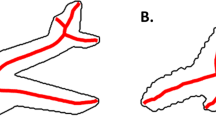Abstract
This paper presents a geometric measure that can be used to gauge the similarity of 2D shapes by comparing their skeletons. The measure is defined to be the rate of change of boundary length with distance along the skeleton. We demonstrate that this measure varies continuously when the shape undergoes deformations. Moreover, we show that ligatures are associated with low values of the shape-measure. The measure provides a natural way of overcoming a number of problems associated with the structural representation of skeletons. The first of these is that it allows us to distinguish between perceptually distinct shapes whose skeletons are ambiguous. Second, it allows us to distinguish between the main skeletal structure and its ligatures, which may be the result of local shape irregularities or noise.
Access this chapter
Tax calculation will be finalised at checkout
Purchases are for personal use only
Preview
Unable to display preview. Download preview PDF.
Similar content being viewed by others
References
C. Arcelli and G. Sanniti di Baja. A width-independent fast thinning algorithm. IEEE Trans. on PAMI, 7(4):463–474, 1985.
J. August, K. Siddiqi, and S. W. Zucker. Ligature instabilities in the perceptual organization of shape. Comp. Vision and Image Und., 76(3):231–243, 1999.
J. August, A. Tannenbaum, and S. W. Zucker. On the evolution of the skeleton. In ICCV, pages 315–322, 1999.
H. Blum. Biological shape and visual science (part I). Journal of theoretical Biology, 38:205–287, 1973.
G. Borgefors, G. Ramella, and G. Sanniti di Baja. Multi-scale skeletons via permanence ranking. In Advances in Visual Form Analysis, 31–42, 1997.
S. Bouix and Kaleem Siddiqi. Divergence-based medial surfaces. In Computer Vision ECCV 2000, 603–618. Springer, 2000. LNCS 1842.
P. J. Giblin and B. B. Kimia. On the local form and transitions of symmetry sets, medial axes, and shocks. In ICCV, 385–391, 1999.
B. B. Kimia and K. Siddiqi. Geometric heat equation and nonlinear di usion of shapes and images. Comp. Vision and Image Understanding, 64(3):305–322, 1996.
B. B. Kimia, A. R. Tannenbaum, and S. W. Zucker. Shapes, shocks, and deforamtions I. International Journal of Computer Vision, 15:189–224, 1995.
P. Klein et al. A tree-edit-distance algorithm for comparing simple, closed shapes. In ACM-SIAM Symp. on Disc.e Alg., 1999.
R. L. Ogniewicz. A multiscale mat from voronoi diagrams: the skeleton-space and its application to shape description and decomposition. In Aspects of Visual Form Processing, 430–439, 1994.
R. L. Ogniewicz and O. Kübler. Hierarchic voronoi skeletons. Pattern Recognition, 28(3):343–359, 1995.
S. J. Osher and J. A. Sethian. Fronts propagating with curvature dependent speed: Algorithms based on hamilton-jacobi formulations. J. of Comp. Physics, 79:12–49, 1988.
M. Pelillo, K. Siddiqi, and S. W. Zucker. Matching hierarchical structures using association graphs. PAMI, 21(11):1105–1120, 1999.
D. Sharvit, J. Chan, H. Tek, and B. B. Kimia. Symmetry-based indexing of image database. J. of Visual Comm. and Image Rep., 9(4):366–380, 1998.
A. Shokoufandeh, S. J. Dickinson, K. Siddiqi, and S. W. Zucker. Indexing using a spectral encoding of topological structure. In CVPR, 1999.
K. Siddiqi, S. Bouix, A. Tannenbaum, and S. W. Zucker. The hamilton-jacobi skeleton. In ICCV, 828–834, 1999.
K. Siddiqi and B. B. Kimia. A shock grammar for recognition. In CVPR, 507–513, 1996.
K. Siddiqi, A. Shokoufandeh, S. J. Dickinson, and S. W. Zucker. Shock graphs and shape matching. International Journal of Computer Vision, 35(1):13–32, 1999.
S. Tirthapura et al. Indexing based on edit-distance matching of shape graphs. In SPIE Int. Symp. on Voice, Video, and Data Comm., 25–36, 1998.
Author information
Authors and Affiliations
Editor information
Editors and Affiliations
Rights and permissions
Copyright information
© 2001 Springer-Verlag Berlin Heidelberg
About this paper
Cite this paper
Torsello, A., Hancock, E.R. (2001). A Skeletal Measure of 2D Shape Similarity. In: Arcelli, C., Cordella, L.P., di Baja, G.S. (eds) Visual Form 2001. IWVF 2001. Lecture Notes in Computer Science, vol 2059. Springer, Berlin, Heidelberg. https://doi.org/10.1007/3-540-45129-3_23
Download citation
DOI: https://doi.org/10.1007/3-540-45129-3_23
Published:
Publisher Name: Springer, Berlin, Heidelberg
Print ISBN: 978-3-540-42120-7
Online ISBN: 978-3-540-45129-7
eBook Packages: Springer Book Archive




